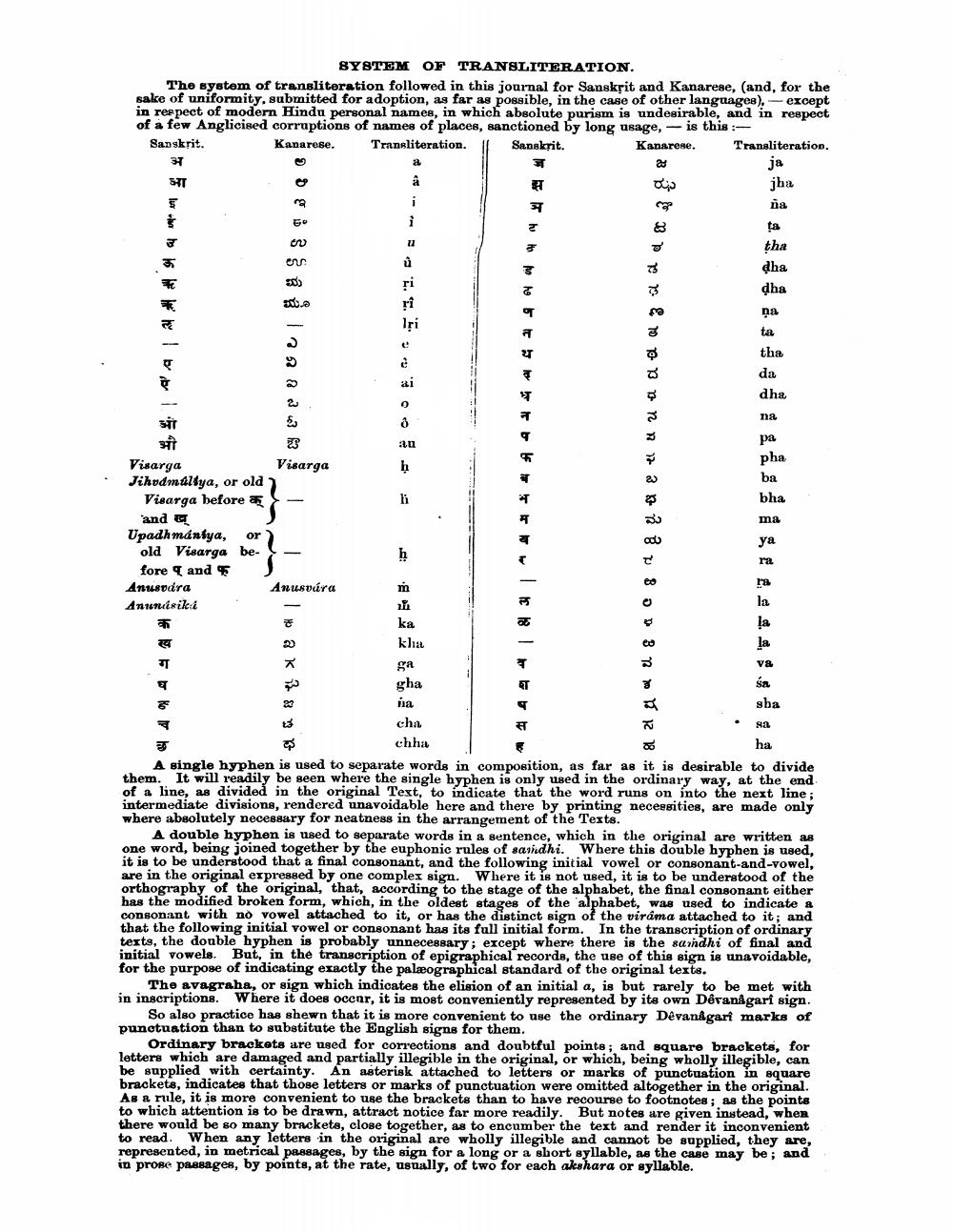________________
BYSTEM OF TRANSLITERATION. The system of transliteration followed in this journal for Sanskrit and Kanarese, (and, for the sake of uniformity, submitted for adoption, as far as possible, in the case of other languages),- except in respect of modern Hindu personal names, in which absolute purism is undesirable, and in respect of a few Anglicised corruptions of names of places, sanctioned by long usage, - is this :Sanskrit. Kanarese. Transliteration. Sanskrit.
Kanarese. Transliteration. 37 आ
jha na
ja
low
us to 16
tha
De B S Ş B 12 a 3 ?
ņa
let hele her lo
tha
23
de 1
dha
na
5
= d. 8 ( 6 8 1 @ g શ ર રા છે a t u d બ 1 2 4 વ શ = વ્ર છ
भो
Visarga
ра pha ba bha
Visarga Jihudmallya, or old
Visarga before
and ख् Upadh mántya, or
old Visarga
fore and Anuspdra Anundsiki
ma ya
Anusvúra
Ito a
k
klia
ga
n
2
gha na cha
• sa chha
ha A single hyphen is used to separate words in composition, as far as it is desirable to divide them. It will readily be seen where the single hyphen is only used in the ordinary way, at the end of a line, as divided in the original Text, to indicate that the word runs on into the next line; intermediate divisions, rendered unavoidable here and there by printing necessities, are made only where absolutely necessary for neatness in the arrangement of the Texts.
A double hyphen is used to separate words in a sentence, which in the original are written as one word, being joined together by the euphonic rules of sarndhi. Where this double hyphen is used, it is to be understood that a final consonant, and the following initial vowel or consonant-and-vowel, are in the original expressed by one complex sign. Where it is not used, it is to be understood of the orthography of the original, that, according to the stage of the alphabet, the final consonant either has the modified broken form, which, in the oldest stages of the alphabet, was used to indicate a consonant with no vowel attached to it, or has the distinct sign of the viráma attached to it; and that the following initial vowel or consonant has its full initial form. In the transcription of ordinary texts, the double hyphen is probably unnecessary; except where there is the sandhi of final and
the transcription of epigraphical records, the use of this sign is unavoidable, for the purpose of indicating exactly the palæographical standard of the original texts.
The avagraha, or sign which indicates the eligion of an initial a, is but rarely to be met with in inscriptions. Where it does occnr, it is most conveniently represented by its own Devanagari sign.
So also practice has shewn that it is more convenient to use the ordinary Devanagari marks of punctuation than to substitute the English signs for them.
Ordinary brackets are used for corrections and doubtful points, and square brackets, for letters which are damaged and partially illegible in the original, or which, being wholly illegible, can be supplied with certainty. An asterisk attached to letters or marks of punctuation in square brackete, indicates that those letters or marks of punctuation were omitted altogether in the original. As a rule, it is more convenient to use the brackets than to have recourse to footnotes; as the points to which attention is to be drawn, attract notice far more readily. But notes are given instead, when there would be so many brackets, close together, as to encumber the text and render it inconvenient to read. When any letters in the original are wholly illegible and cannot be supplied, they are, represented, in metrical passages, by the sign for a long or a short syllable, as the case may be ; and in probe passages, by points, at the rate, usually, of two for each akshara or syllable.




